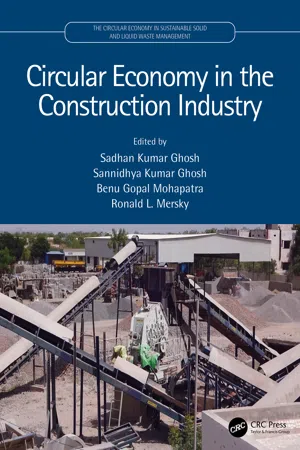1.1 Introduction
Disasters occur in various forms creating lots of problems for mankind and for the environment. The modes of disaster may happen in many forms, such as, natural or man-made; sudden onset (such as earthquake, fire, flood, tsunami, hurricane and volcano) or prolonged onset (such as civil conflict or drought); with varying degrees and types of physical and social impacts: The impacts of disaster in terms of material damage exceed the capacity for self-recovery of local communities. Disasters in many events create significant volumes of debris. In many cases, this satiation exceeds the existing city capacity of waste management. More than 3.0 billion tonnes annually, up to 2012, of construction and demolition waste (C&DW) was generated in 40 countries with an increasing trend. This C&DW generation has a different dynamic than the generation of municipal waste. C&DW can be generating from manmade activities as well as from natural disasters. Hence the generation of C&DW in many countries does not match with the estimated value. Nepal is one of such examples.
Sand and gravel are the main constituents: 35 tons of non-metallic minerals was extracted globally in 2010. A decrease in the quantity of raw materials and effective long-term planning can enable materials in structures to work as storage banks for significant materials and items following the concepts of 3Rs (Reuse/Recover/Recycle) and circular economy in the afterlife of the building. The waste products in the construction industry account for 30% of landfill waste worldwide (Ghaffar et al., 2020). India generates an estimated 150 million tonnes of C&DW every year (Building Material Promotion Council) while the recorded recycling capacity is 6,500 tonnes per day (Vidyasekar, 2019). This needs the support from government and respective legislation in the country. This study reviews the status of generation and utilisation of C&DW including disaster wastes. Policy instruments exist in a few countries, such as, India, USA, and a several other countries, management, and recycling. A case study from Nepal is presented. The study presents a generic model of C&DW management generated from manmade and natural disaster paths. The existing 6–9% of the global economy that is circular needs to be enhanced.
Eco-conscious construction trends and the increasing number of non-residential green buildings in the USA are driving the explosion in demand for green building materials while the green building materials market is estimated to reach $1 trillion in 2021. Non-residential buildings compose 40–48% of green buildings in the USA, which was only 1.4% in 2005. This green construction trend was responsible for over 3.3 million jobs created in 2018.The Global Green Building Materials market was estimated at $199.9 billion. The US Green Building Council 2019 report states that, LEED (Leadership in Energy and Environmental Design)—certified homes have grown 19% since 2017 and are at an all-time high with nearly 0.5 million LEED-certified housing units globally and more than 0.4 million units located in the USA. The Canadian green building sector can reduce the Greenhouse Gases (GHG) by 53 megatons in comparison to 2018 levels. This will enhance the interest and business for green building materials in the construction of greenhouses [Canada Green Building Council (CaGBC)]. Due to the pandemic Covid-19, the market throughout the world was negatively impacted. However, this is a temporary setback that is expected to recover soon in the coming years.
1.2 Construction and Demolition Waste (C&D) Generation Including Disasters Debris
When new buildings and civil-engineering structures, such as highways and streets, bridges, utility plants, piers, and dams, are built, renovated or demolished generation of C&DW materials occur. The rate of generation of C&DW is increasing with the population increase and the GDP growth in many countries. These C&D materials consists of bulky & heavy materials, such as, concrete, wood, asphalt, gypsum, metals, bricks, glass, plastics, doors, windows, plumbing fixtures, trees, stumps, earth, rock from clearing sites, and many others. C&DW is one of the largest waste supply chain varying from 30–40% of total solid waste in large-scale C&D activities due to the accelerated urbanisation and city rebuilding (Akhtar & Sarmah, 2018; Jin et al., 2017; Zhao et al., 2010). Globally, about 35% of the C&DW produced is directed to landfills, without any further treatment, although efforts to recycle and reusing C&DW are increasing day by day (Maria et al., 2018). The growth rate of C&DW generation is quite higher in Australia (44%) (Poon et al., 2013). The rates of urbanisation in Bangladesh, between 2000 and 2010, was the fastest among the South Asian countries with an increase of 28% in 2011 (World Bank, 2015). Nearly 3.0 billion tons of C&DW annually, until 2012, was generated in 40 countries with an increasing trend.
There are two generation paths of C&DW—manmade C&DW and natural disaster debris. India generates an estimated 150 million tons of C&DW annually. It has been observed that the amount of C&DW generated varies from 30–200% of the municipal waste generated. Data management of C&DW is very weak in most of the developing countries. Researchers worked on quantification and optimisation models of C&DW (Ghosh et al., 2016, Alcántara-Ayala 2002). C&DW can be classified into three categories taking the phases into consideration: construction waste, renovation waste and demolition ...
